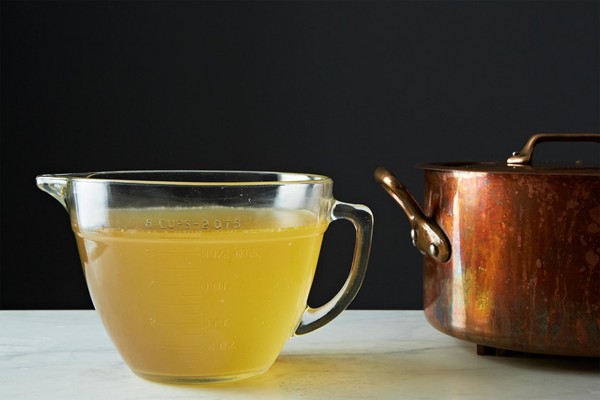Stock vs. broth
January 9, 2015 by Darcie
Stock is a fundamental culinary building block. While it’s been around for ages, there’s been renewed interest in stock and its close relative broth, partly due to the Paleo trend, which relies on something called “bone broth” as a cornerstone of the diet. Julie Moskin of The New York Times reports on the explosion of bone broth drinks available at restaurants, including some eateries that specialize in broth only.
While the terms stock and broth get used interchangeably, “strictly speaking, both broth and stock include bones and meat, but stock has a higher proportion of bones to meat.” (This definition, however, excludes vegetable broth. Moskin also says that aromatics are optional, a point with which many chefs would disagree.) But if you are speaking about meat-based products, a greater proportion of meat to bones is the difference between stock and broth, agrees Michael Ruhlman.
The award-winning author thinks that stock and broth are very similar, but that stock “is often bone heavy. Bones don’t add a lot of flavor, but they are composed of connective tissue, which gives body to a stock…cartilage gives tons of body (from the gelatin), so the more joints you use, the better. Meat is where most of the flavor comes from, so don’t skimp on that.”
Even though most culinary professionals agree on these differences between stock and broth, there is no specific ratio that provides a clear dividing line; it’s basically an interpretation by the cook. And sometimes even professionals mess up the definition – on the Today Show this morning, a chef said that stock contained more meat. So if you sometimes get tripped up by the terms, don’t feel bad–you’re not alone.
While stocks are simple yet essential cooking cornerstones, they vary considerably. In addition to the use of different types of meat and bones, there are also brown and white stocks, second-run stocks, half stocks and double stocks. In addition, many unctuous sauces rely on reduced stocks for body and flavor. The EYB Library contains many great resources to learn more about these kitchen essentials, including Harold McGee’s On Food and Cooking, James Peterson’s Sauces, the venerable Larousse Gastronomique, and Michael Ruhlman’s Ratio.
For the most part, those resources focus on classic Western stocks, and don’t delve much into other broths like miso and dashi. Can you help identify good sources for those (and also tell me what books I overlooked in my abbreviated listing)?
Photo of How to make chicken stock without a recipe from Food52
Categories
- All Posts (6940)
- Antipasto (2135)
- Author Articles (247)
- Book News (935)
- Cookbook Giveaways (983)
- Cookbook Lovers (257)
- Cooking Tips (109)
- Culinary News (299)
- Food Biz People (552)
- Food Online (791)
- Holidays & Celebrations (272)
- New Cookbooks (149)
- Recipes (1500)
- Shelf Life With Susie (231)
- What's New on EYB (133)
Archives
Latest Comments
- eliza on What foods do you look forward to the most for each season?
- kmwyman on Rooza by Nadiya Hussain – Cookbook Review and Giveaway
- Maryd8822 on The Golden Wok – Cookbook Giveaway
- Dendav on Danube Cookbook Review and Giveaway
- sanfrannative on Rooza by Nadiya Hussain – Cookbook Review and Giveaway
- darty on Danube Cookbook Review and Giveaway
- Atroyer7 on Danube Cookbook Review and Giveaway
- demomcook on What foods do you look forward to the most for each season?
- demomcook on Danube Cookbook Review and Giveaway
- Darcie on How cookbooks can help build resilience